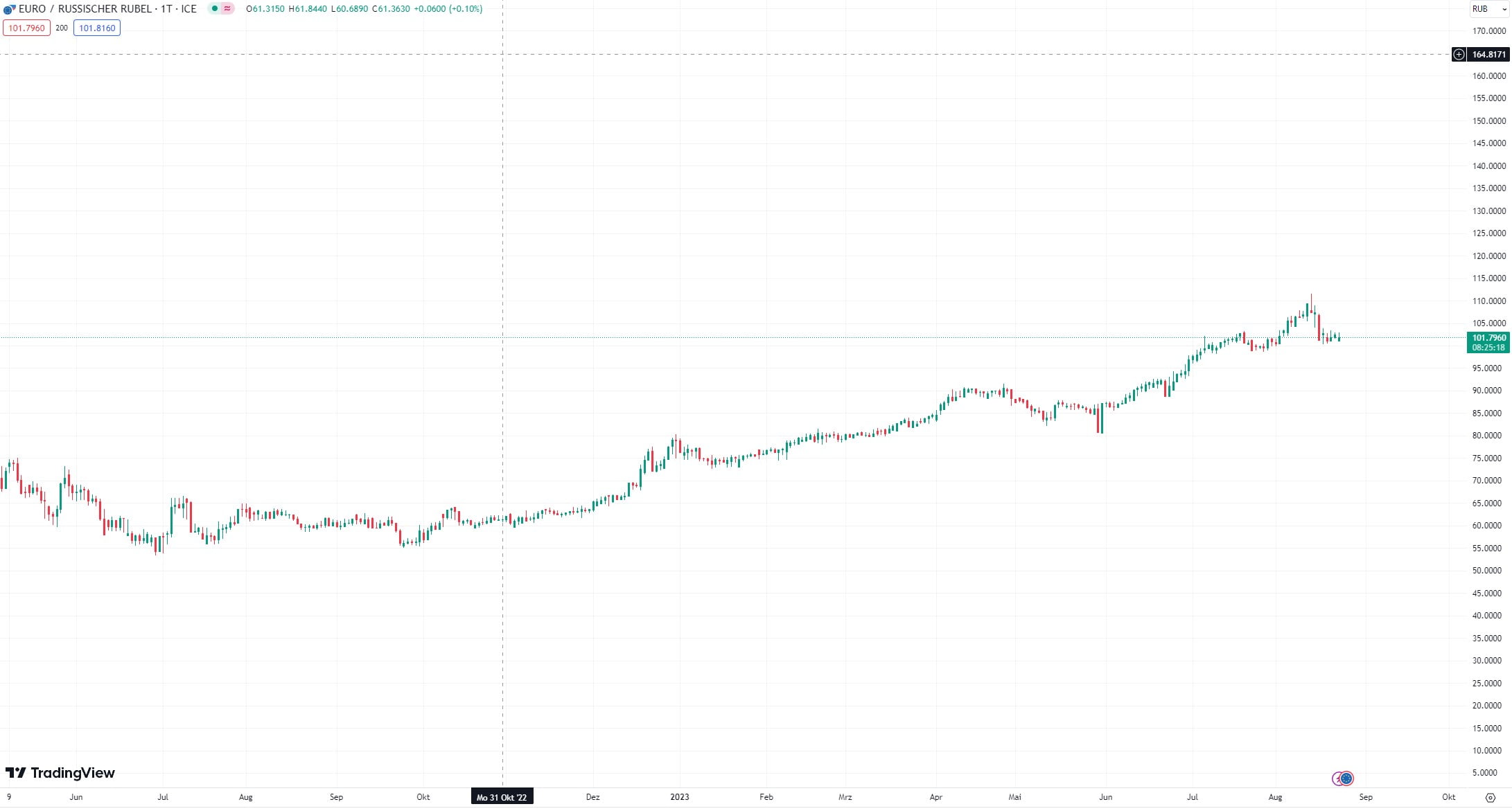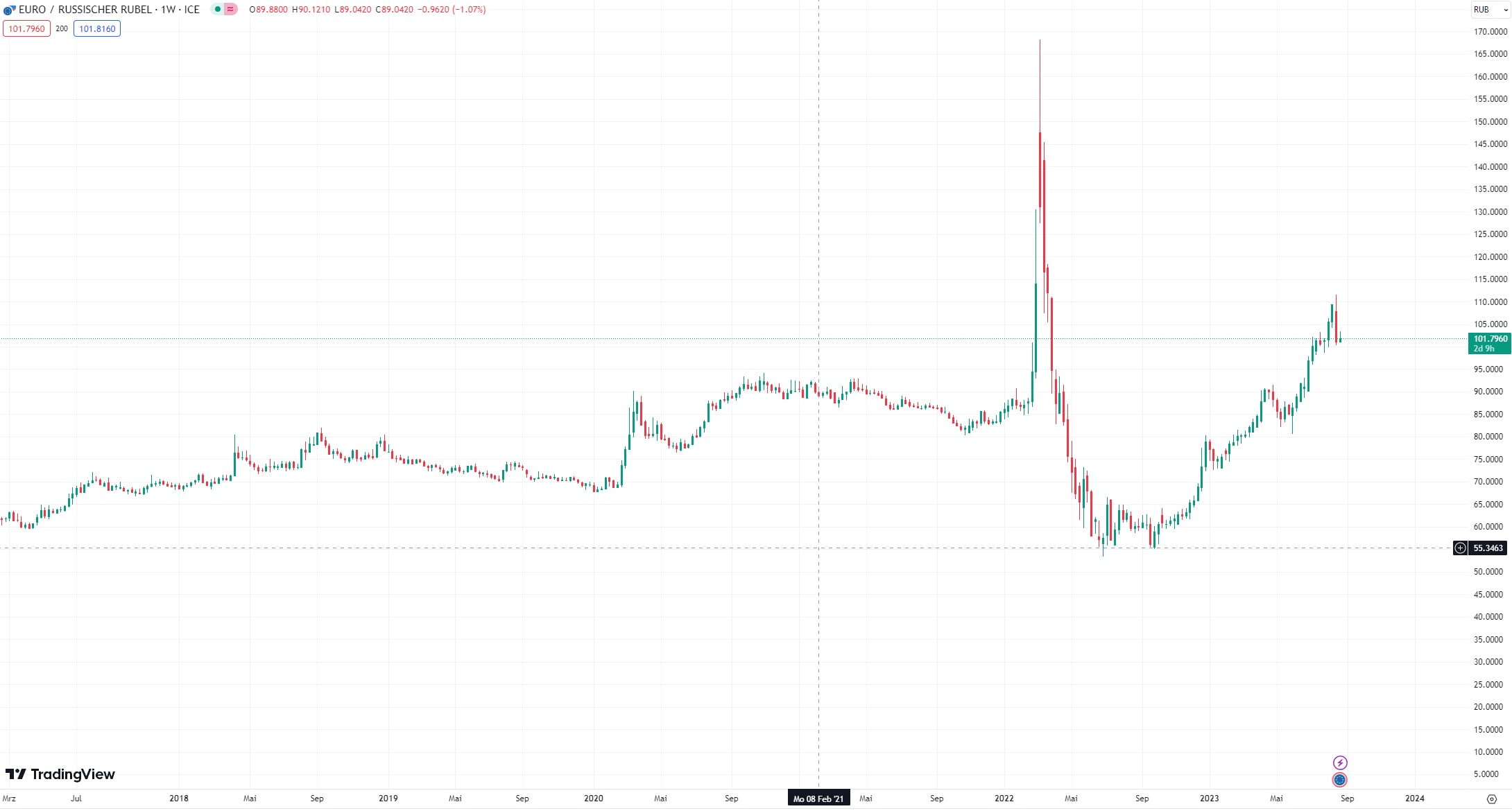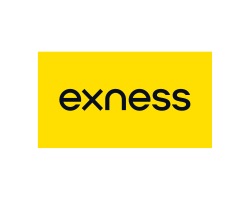Live Chart Of EUR/RUB
1. Understanding EUR/RUB Forex Trading Pair
Trading the EUR/RUB pair demands intricate knowledge of the financial systems of both the Eurozone and Russia. It’s essential to recognize the unique economic factors and geopolitical events that influence each currency. Dynamics such as Russian energy exports, primarily oil and natural gas, can severely impact the value of the Ruble. When Russia’s energy exports surge, the Ruble typically strengthens against the Euro, and vice versa.
The Euro, on the other hand, is heavily influenced by factors such as socio-political situations within the EU, economic performance indicators, or key interest rate decisions made by the European Central Bank – ECB. An improvement in these factors usually bolsters the Euro against the Ruble. Therefore, being abreast with such crucial updates provides a trader with predictive insight on exchange rate movements.
A successful strategy for trading EUR/RUB relies heavily on proficient technical analysis. Identifying trends, resistance, and support levels through graphical representations of past market activity can provide traders with vital clues about potential future movements. Tools such as moving averages, Fibonacci retracements, and pivot points are of great value in this endeavor.
Leveraging economic calendar updates is another smart approach when dealing with the EUR/RUB pair. Major announcements, such as GDP figures, inflation rates, and employment statistics, often lead to significant market volatility. By closely following the economic calendar, traders can identify trading opportunities as these major announcements often create currency price spikes.
In the forex trading realm, the high volatility of the EUR/RUB pair can be as much a blessing as a hindrance. While volatility offers opportunities for significant profits, it also presents substantial risk. Effective risk management strategies, including setting stop losses and taking profits, are crucial in safeguarding one’s investment capital. Every trader should incorporate such strategies to balance the prospect of profits against the potential for losses.

If you require more advanced charting capabilities, we can recommend Tradingview.
1.1. Basic Characteristics of EUR/RUB Pair
The EUR/RUB pair is an enticing yet complex market for traders. Packed with volatility due to the interaction between two major economies – the Eurozone and Russia. Brought to life by the fluctuation between the Euro (EUR) and Russian Ruble (RUB), this pairing is influenced by numerous economic, political, and environmental factors. For traders who love a challenge, trading this pair offers considerable opportunity.
The high volatility in the EUR/RUB pair drives an equally high-risk environment. Nevertheless, it’s this very unpredictability that attracts traders seeking significant rewards. Traders need comprehensive understanding of the economic indicators that sway both the Euro and Ruble, including interest rates, GDP, inflation, and even geopolitical events.
Diving into the market, the liquidity of the EUR/RUB pair stands out. Typically, liquidity refers to the ease with which an asset or security can be bought or sold without causing significant price changes. Given the significant trading volumes driven by Russia’s economic activities and the Eurozone’s global prominence, liquidity is generally high in this pair.
While the EUR/RUB pair might not be ideal for beginners, its unique properties provide experienced traders with fascinating opportunities to potentially benefit from its currency movements. This requires well-informed decisions relying on technical analysis, key economic indicators, and a reliable risk management strategy.
1.2. Importance of Foreknowledge in Trading EUR/RUB
Traders across the globe are continuously seeking strategies to better position themselves to capture opportunities in the financial markets. One pivotal framework for making better trading decisions is arming oneself with foreknowledge. In the context of EUR/RUB trading, this foreknowledge encompasses understanding both the intricacies of the FX market and the economic factors influencing the Euro and the Russian Ruble.
Deep knowledge of the European and Russian economies respectively avails an invaluable edge. Key economic datasets, including GDP, trade balance data, and inflation rates, serve as leading indicators of a currency’s strength on the international stage. Trading without these critical insights is akin to driving a car blindfolded – the chances of accidents are rife.
Monitor Monetary Policy decisions by the European Central Bank (ECB) and the Central Bank of Russia (CBR). Unanticipated decisions may spur significant moves in the EUR/RUB exchange rate. Keep abreast with meeting minutes, speeches, and official statements from these central banks. They tend to hint at future policy directions, potentially precipitating noticeable fluctuations in the currency pair.
The impact of Political Uncertainty on the EUR/RUB currency pair should not be underestimated. Elections, referendums, or changes in governance can cause immediate and long-term shifts in a currency’s strength against its counterpart. Such events can impact investor confidence, economic policy, and the direction of trade, affecting the EUR/RUB exchange rate dramatically.
Unexpected occurrences under the umbrella of Market Shocks like natural disasters, wars, pandemics also have the potential to disrupt currencies’ strength, causing drastic moves in the EUR/RUB trading pair. Keeping tabs on such events aids in constructing scenarios, preparing for drastic moves, and mitigating undue losses.
Thus, trading the EUR/RUB pair, while potentially lucrative, implores the need for a nuanced knowledge base and staying abreast with global news and market happenings to aptly seize opportunities while avoiding potential pitfalls. As they say in the world of trading – information is power.
2. Effective Strategies for Trading EUR/RUB

If you require more advanced charting capabilities, we can recommend Tradingview.
Understanding the complexities of the EUR/RUB pair is vital in formulating a successful trade. Renowned as a volatile foreign exchange pair, the importance of due diligence cannot be discounted. The evolving political climate and macroeconomic developments often drive the value of the Russian Ruble against the Euro.
Technical Analysis is a proven strategy for trading this pair. Analyze patterns, draw trendlines, and use indicators such as moving averages or Bollinger Bands. These tools can provide valuable insights into future price movements and trading opportunities.
In addition, Event-Driven Trading can lead to substantial profits. Keep a close eye on economic calendars and geopolitics, as news surrounding interest rates, GDP data, or European and Russian relations often trigger market volatility.
The use of Risk Management measures can also make a difference in your EUR/RUB trading. Determine a suitable leverage ratio, set appropriate stop loss and take profit levels, and manage your investment wisely. Prioritize risk management to protect your account from unexpected market swings.
A Fundamental Analysis based strategy is another effective approach to trading EUR/RUB. Focus on factors affecting the economies of both regions, such as inflation, unemployment rates, and geopolitical tensions.
Each method possesses its own merits and potential pitfalls. Traders should opt for a comprehensive approach, integrating various strategies tailored to their individual risk tolerance and investment objectives.
2.1. Trend Following Strategy
Trend Following Strategy is a widely utilised approach, particularly effective when it comes to trading the EUR/RUB pair. This technique revolves around tracking price trends in historical data with a primary objective to buy or sell an asset based on its recent and ongoing market direction. It’s impressive how the hands-off nature of this strategy enables traders to make well-informed decisions without being glued to their screens.
Delving deeper, the use of technical analysis tools, such as moving averages, becomes vital. By plotting the average price over a chosen period on the price chart, traders gain a visual representation of market trends. When trading EUR/RUB, moving averages can provide insightful details about potential future market momentum.
However, every strategy has its limitations. Although Trend Following is an instrumental tool for systematising trading decisions and removing human emotional interference, it is important to consider the risk of sharp reversals or markets without a clear trend. Nonetheless, the volatility inherent in the EUR/RUB pair often provides ample opportunities for traders to benefit from price movements.
Keeping a close eye on global economic factors is always important. Changes in European or Russian financial policies can generate trends that might not be visible through technical analysis alone. Combining the Trend Following Strategy with reliable financial news sources can drastically enhance the trader’s insight into EUR/RUB trends.
Finally, it is prudent to use stop-loss orders while using this strategy. Unexpected changes in currency rates could result in significant losses. Stop-loss orders can limit potential losses by automatically closing out a trade if the price moves against you.
It can be inferred that when coupled with careful risk management, the Trend Following Strategy could potentially be highly profitable when applied to the EUR/RUB currency pair. This approach certainly merits consideration for those seeking to navigate the choppy waters of Forex trading successfully. Remember, consistency is key in trading. Balancing patience, discipline, and strategic application of trend following methodologies can translate into impressive returns in the long run.
2.2. Breakout Strategy
The Breakout Strategy is a popular approach to trading the EUR/RUB pair. It involves identifying crucial price levels that the market has persistently failed to surpass – these are called resistance levels on the higher end, and support levels on the lower end. With keen observation and precise analysis, traders identify potential ‘breakout’ points where the currency pair might rise above resistance or fall below support levels.
Use of technical analysis is vital in breakout strategy. Tools like Candlestick Charts and Fibonacci retracement aid in identifying breakout points. The breakout strategy warrants that positions are only entered when the price breaks these levels and not before. Traders often place orders just beyond these designated points, ready for execution.
Cautious application of the Stop Loss function is an integral part of the breakout strategy. It’s implemented to limit any potential losses if the price takes an unforeseen turn. Despite its name, the breakout strategy doesn’t guarantee profits at constantly rising or falling prices. It’s essential to be aware of the market’s volatility and unpredictability – a ‘fakeout’, or a simple price fluctuation, may seem like a breakout, leading to potential losses.
Don’t forget to take into account other influencing factors such as the overall trend in the market, political events, economic news, and any other circumstances involving the Eurozone or Russia. These factors often disrupt the EUR/RUB markets causing potential breakouts. Being familiar with these events can help traders predict breakouts more accurately.
Demonstrating flexibility and adaptability is critical in capitalizing on this approach. As markets evolve, traders should constantly revise and adapt their strategies, indicators and risk management plans to remain profitable. A static approach in a dynamic market can often lead to failure. The breakout strategy is no exception to this rule.
2.3. Counter-trend Strategy
Just as every coin possesses two faces, so does the realm of foreign exchange trading. As a trader, adhering strictly to a consistent trend might be an intuitive choice. Yet, a seasoned trader knows that tacking against the wind – or a counter-trend strategy – can also yield fruitful results. Imagine you are trading the pair EUR/RUB. As the market pace speeds up, it’s quite common to observe a single-directional trend.
In such a conducive scenario, implementing a counter-trend strategy signifies entering a trade that opposes the current movement. The essence of this daring tactic lies in the attempt to capitalize on the transient period when market trends reverse briefly before reverting solidly back to the initial movement.
Executing this requires pinpoint market perception and precise execution, determining the stir in the wind early enough to profit from the transitory oscillation. For example, should the EUR/RUB fall consistently, a counter-trend approach would involve buying this pair in anticipation of a temporary price rise before the principal downfall ensues.
Wielding careful risk management and meticulous stop-loss orders are the dual shields protecting you in this endeavour, limiting losses if the expected turn does not materialize. Remember, while the counter-trend strategy has the potential to harvest significant yields, it is susceptible to high risk, too. Therefore, it’s best suited for experienced traders confident handling swift market shifts and bearing the attached risks.
3. Role of Technical Analysis in Trading EUR/RUB

If you require more advanced charting capabilities, we can recommend Tradingview.
Technical analysis plays a pivotal role in effective EUR/RUB trading. It aids in predicting potential price movements by analyzing past market data, primarily price and volume. The fundamental flaw in relying solely on fundamental analysis is assuming that all factors impacting market price have been accounted for. These assumptions can lead to untimely or misinformed trade decisions. Here’s the power of technical analysis: it allows traders to identify market trends, providing them with signals and indicators to help them make informed trade decisions.
Price charts are the backbone of technical analysis and come in various forms such as line charts, bar charts, and candlestick charts. They basically offer a visual representation of EUR/RUB exchange rate fluctuations within a specified period. And with these charts, technicians can apply various technical studies to identify trading opportunities.
Trend identification is another pivotal aspect of technical analysis. Traders can identify market trends by using various trend indicators like Moving Averages, MACD, and Relative Strength Index. For example, a trader can use Moving Averages to determine whether the current trend for EUR/RUB is bullish or bearish, providing them insights into when to enter or exit a trade.
Volume analysis also plays a critical role. It essentially measures the number of shares or contracts traded in an asset or security. In forex trading, it can help assess the strength of a price move as significant price changes are usually accompanied by large trading volumes.
Consequently, using technical analysis tools could lead to more effective decision-making in EUR/RUB trading. The ability to interpret price charts, locate trends, and evaluate volumes can help to predict future market movements, potentially providing traders with pre-emptive, profitable trade opportunities. It’s important to note, however, that while technical analysis can be a tracker’s gps in the volatile terrain of EUR/RUB trading, it does not guarantee success.- As with any investment strategies, risks are involved, and using technical analysis should be part of a broader, well-diversified trading strategy.
3.1. Application of Technical Indicators
Technical indicators play a pivotal role in the realm of forex trading, especially when trading pairs like EUR/RUB. These numerical metrics provide traders with an insight into market trends, future price movements, and volatility indices. By understanding these movements, traders can make informed decisions and improve their odds of success.
A primary and incredibly valuable tool in this regard is the Moving Average (MA). Serving as a continuous calculation, MA helps smooth out price data by creating a constantly updated average price. This is especially helpful to identify directional trends, and in the context of trading EUR/RUB, using MA can present potential opportunities based on any ongoing or upcoming currency trends.
A step beyond is the Relative Strength Index (RSI), helping traders identify if a currency pair has been overbought or oversold. In essence, it gauges the speed and change of price movements. RSI acts as an oscillator, moving between zero and 100, providing traders with subtle hints about a market’s reversal. For EUR/RUB, these signals can be the difference between a successful trade and a costly mistake.
Lastly, there is the Bollinger Bands indicator. It encloses the price action of a currency pair within a price channel, offering dynamic support and resistance levels. By understanding when EUR/RUB prices breach these bands, traders can better predict potential buy or sell opportunities.
Understanding these technical indicators and how they apply to the EUR/RUB trading can assist in making strategic currency moves. Leveraging them to predict market behavior aids in developing sharper, more precise trading strategies, and robust profits. In the high stakes game of forex trading, knowledge is power, and the application of these indicators provides plenty of it.
3.2. Chart Pattern Analysis
Chart pattern analysis is paramount in trading the EUR/RUB pair as it provides an understanding of both currency’s price action. This involves the identification of key patterns on charts reflecting the traders’ sentiment and the overall market psychology. It can visually represent periods of accumulation, consolidation, and distribution of the currencies.
Making use of ‘Support’ and ‘Resistance’ – two pivotal elements in chart pattern analysis – these levels are price points on a chart where the probabilities favour a pause or reversal of a prevailing trend. Support occurs when falling prices stop, change direction, and begin to rise. It is evidenced by a horizontal line connecting the lows. On the other hand, resistance is where rising prices halt, change direction, and start to drop, marked by a line connecting the highs.
Head and Shoulders, Double Tops and Bottoms, and Triangles are typical examples of patterns that can be identified on a chart. The Head and Shoulders pattern signals a reversal pattern, suggestive of a bearish sentiment. Double Tops and Bottoms are also reversal patterns, but they usually surface in uptrends (double tops) or downtrends (double bottoms). A triangular pattern, conversely, can be either a continuation or a reversal pattern, depending on its form, and usually appears during consolidation phases.
With the EUR/RUB pair, volatility is king, therefore when patterns begin to form around significant levels of support and resistance, they provide high-probability trading opportunities. Notwithstanding, careful attention is required in discerning the market sentiment underpinning these patterns. Frequent refreshing of market knowledge enhances the trader’s capacity to respond appropriately to chart patterns, fostering effective EUR/RUB trade execution.
4. Importance of Risk Management in EUR/RUB Trading
Risk management is a pinnacle structure that shapes the trading experience. Specifically in the EUR/RUB trading market, it plays a significant role in delineating successful trades from costly missteps. Risk management is an indispensable tool that imparts a sense of direction amidst the constantly fluctuating market trends. When trading EUR/RUB, one’s actions should be guided primarily through a disciplined approach, of which risk management forms an integral part.
Controlling losses is where risk management proves its mettle. In forex trading, and especially in something as volatile as the EUR/RUB pair, markets can swing wildly in a single trading session. Without appropriate risk control measures in place, such movement can engulf a substantial portion of your trading capital. A strategic implementation of stop-loss orders and take-profit points is advised to keep losses to a minimum and turn potential losses into profitable exits.
A risk management strategy also extends beyond technical safeguards and into one’s personal attitude towards trading. Maintaining a balanced emotional state is paramount when dealing with EUR/RUB. Unfettered emotions can lead to impulsive decisions that may cause increased exposure to unnecessary risks. Traders should endeavour to maintain an objective outlook on the market and calibrate decisions based on clear analysis over emotional impulses.
Calculating risk-reward ratio is another tool in effective risk management. Evaluating the potential risk against the potential reward of a trade ensures that only trades worth the risk are engaged in. In the world of EUR/RUB trading, this can mean the difference between ephemeral success and long-lasting prosperity.
Lastly, risk management helps to develop consistency in trading. Consistent actions produce consistent results – an invaluable trait in the unpredictable EUR/RUB market. By leveraging risk management strategies, a trader paves a clear path towards achieving trading objectives. This consistency serves as the foundation of a robust trading plan. Never underestimate the importance of risk management in EUR/RUB trading. It’s not just an option; it’s a necessity.
4.1. Balancing Risk and Reward
Balancing risk and reward in EUR/RUB trading is a fundamental concept in achieving long-term success. A trader taking even the slightest step into the world of Forex might have come across the terms of Risk/Reward Ratios. This important metric reflects the potential ‘reward’ which a trader can receive for the ‘risk’ taken. The well-calculated risk can result in substantial gains when the EUR/RUB exchange rates swings in the right direction.
Stop-loss and Take-profit levels are deemed vital techniques correlated to the concept of risk and reward. A wise trader always sets his/her stop-loss orders at a points where potential losses will be limited, suggesting a level of risk tolerance. On the contrary, take-profit orders are set where a trade will wind up, indicating the reward expected from the particular trade. Achieving an optimal balance between risk and reward suggests a successful Forex trading strategy.
Leverage is another vital concern while trading EUR/RUB. This financial instrument intensifies exposure to the market and boosts the potential for profit. But it’s a double-edged sword! Leveraged Forex trading might offer higher gains, yet concurrent losses can be equally magnified. Hence, managing leverage, and thereby managing risk, is vital while dealing with the volatilities of EUR/RUB.
In essence, traversing the tumultuous terrains of EUR/RUB trading without a well-planned risk and reward strategy can turn concerning. Solid experience, careful analysis and mindful strategy implementation pave the path to navigate the twists and turns with astute acumen, thereby achieving the ideal balance between risks and rewards.
4.2. Emotion Control and Trading Discipline
In the realm of forex trading, emotion control and trading discipline are vital components for successful ventures when dealing with currency pairs such as EUR/RUB. The nature of the market ensures it is volatile; thus, traders are subjected to a rollercoaster of emotions. In moments of extreme market alteration, anxiety and euphoria can cloud judgment leading to improper decision-making.
Utilizing emotion control effectively enables traders to remain poised under pressure. Acknowledging your emotions and preventing them from impacting your trading decisions is a skill that requires constant nurturing. Emotional investing can often lead to chasing losses or prematurely closing positions due to fear of potential loss.
Building trading discipline is every bit as significant as controlling emotions in trading. Implementing a well-crafted strategy and adhering to it ensures consistency, thereby reducing the chance of irrational trading decisions. Merely executing trades based on solid analysis and set rules, rather than impulsive moves, amplifies the probability of consistent results.
Nullifying the influences of emotions and practicing strict discipline will not eliminate losses entirely but it will help in managing and minimizing them. This discipline and control over emotions cultivate an environment that maximizes potential returns when trading EUR/RUB.











